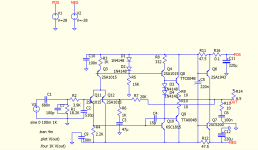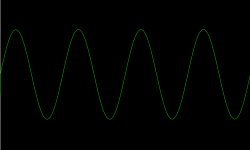Since the typical power amp is class A only within the crossover region, perhaps they should be called BAB ? 😉
Merry Christmas!
Merry Christmas!
Also, there's a tendency to look at the voltages linearly instead of logarithmically.
In my Exicon sims, 1W or ±4Vpk was about the limit of class-A @ 200mA. 0-30V rails would dissipate 6W, with a maximum of about ±10-12V or 6.25-9W at hard clipping (without doing anything special to overdrive the MOSFETs and salvage maybe ±2-3V of wasted rail voltage).
But that's only 6:1, maybe 9:1. The sensible thing to do would be to devote the entire upper 5-8W to soft clipping, which could then compress another 10dB of low-importance bangs and explosions (depending on programme material). To accommodate that linearly, those peaks would push the amplifier into the 40-50W class with nominal ±30V rails and twice the idle power, and 2x again if you want to accommodate 4 ohm speakers.
With that in mind, class-B then prioritises keeping idle power low, but still requiring a lot of 'bulk' to support peak power requirements. So I think the interesting comparison is not so much between class B vs AB per se, but class B vs a truer alternative like low-voltage AB with soft clipping.
In my Exicon sims, 1W or ±4Vpk was about the limit of class-A @ 200mA. 0-30V rails would dissipate 6W, with a maximum of about ±10-12V or 6.25-9W at hard clipping (without doing anything special to overdrive the MOSFETs and salvage maybe ±2-3V of wasted rail voltage).
But that's only 6:1, maybe 9:1. The sensible thing to do would be to devote the entire upper 5-8W to soft clipping, which could then compress another 10dB of low-importance bangs and explosions (depending on programme material). To accommodate that linearly, those peaks would push the amplifier into the 40-50W class with nominal ±30V rails and twice the idle power, and 2x again if you want to accommodate 4 ohm speakers.
With that in mind, class-B then prioritises keeping idle power low, but still requiring a lot of 'bulk' to support peak power requirements. So I think the interesting comparison is not so much between class B vs AB per se, but class B vs a truer alternative like low-voltage AB with soft clipping.
Last edited:
Well they are not really class A at cross over, as one switches on the other switches off, neither is fully conducting, its a transition. There are amps that definitely go BAB, and they always show more distortion (for large signals) than a properly biased class B due to the doubling of gm in the class A region - these amps have two transitions.Since the typical power amp is class A only within the crossover region, perhaps they should be called BAB ? 😉
Merry Christmas!
Class B endevours for gm to be as constant as possible over the join. Its informative to look up wing-spread diagrams for various types of output biasing. Google "wingspread diagram amplifier" if you don't want to end up with lots of pictures of birds' wings!
Happy Xmas!
Isnt the output of most operation amplifiers usually class B ? Or are the days gone when this was certainly true?
Happy Xmas to all !
Happy Xmas to all !
There has been a transition going on from class B to D in recent years/decades, but it’s not complete yet. In some markets, yeah it is almost complete. But D is altogether different and there is no confusing it with B, AB, or A.
Everyone here seems to be splitting hairs as to what to call B vs. AB, or even C. How close to exactly a 180 degree conduction angle does it actually have to BE to call it class B? There is no hard and fast rule. In my personal judgement ANY amp running close to a 180 degree conduction angle, whether it’s biased a little on, at an optimum bias for distortion, or with a tiny dead zone of a few tens of mV is class B. It can be over biased, optimally biased, zero biased, or underbiased - but still basically class B. You would have to bias it up to significant intentional overlap (and dissipation) to call it AB, or retard the conduction angle significantly and on purpose to call it C.
gm doubling that results from ovebiasing class B or running heavily (multiple watts) into AB isn’t the end of the world. The voltage gain of a follower is only weakly dependent on gm. So there is a is range of bias that works reasonably well, and a smaller one that is optimum. If you want it optimum, you need to maintain tighter control. That’s on the designer. But it’s not going to be at a high enough Iq that I’d have to call it “AB”. Back in the days of tubes where output stages were typically common cathode, the voltage gain was DIRECTLY proportional to gm so you HAD to bias the output tubes high enough go even get some gm at all - and you counted on gm doubling to linearize the composite gm. Which was about 2X at full signal compared to quiescent. The effective doubling that occurs when both tubes of a push pull pair are conducting is exactly what you want. And as one decreases as it approaches cutoff the other increases. The optimum bias for overall linearity was often right at the tube’s dissipation limit. And could even be above it. That high of a bias is clearly AB.
Everyone here seems to be splitting hairs as to what to call B vs. AB, or even C. How close to exactly a 180 degree conduction angle does it actually have to BE to call it class B? There is no hard and fast rule. In my personal judgement ANY amp running close to a 180 degree conduction angle, whether it’s biased a little on, at an optimum bias for distortion, or with a tiny dead zone of a few tens of mV is class B. It can be over biased, optimally biased, zero biased, or underbiased - but still basically class B. You would have to bias it up to significant intentional overlap (and dissipation) to call it AB, or retard the conduction angle significantly and on purpose to call it C.
gm doubling that results from ovebiasing class B or running heavily (multiple watts) into AB isn’t the end of the world. The voltage gain of a follower is only weakly dependent on gm. So there is a is range of bias that works reasonably well, and a smaller one that is optimum. If you want it optimum, you need to maintain tighter control. That’s on the designer. But it’s not going to be at a high enough Iq that I’d have to call it “AB”. Back in the days of tubes where output stages were typically common cathode, the voltage gain was DIRECTLY proportional to gm so you HAD to bias the output tubes high enough go even get some gm at all - and you counted on gm doubling to linearize the composite gm. Which was about 2X at full signal compared to quiescent. The effective doubling that occurs when both tubes of a push pull pair are conducting is exactly what you want. And as one decreases as it approaches cutoff the other increases. The optimum bias for overall linearity was often right at the tube’s dissipation limit. And could even be above it. That high of a bias is clearly AB.
That doesn't actually have any meaning. The RF definition encompasses what happens over all 360 degrees of the cycle. Not just the crossover region.Since the typical power amp is class A only within the crossover region,
My quip wasn't an attempt to add any real contribution. I was just having fun.
Merry Christmas, everyone!
Merry Christmas, everyone!
Didn't lots of radios and other early transistor gear use class B stages?
https://incbtech.com/circuit-bench/1444-push-pull-class-b-transistor-amplifier-cb927e.html
https://www.rfcafe.com/references/e...-circuits-november-1960-electronics-world.htm
https://incbtech.com/circuit-bench/1444-push-pull-class-b-transistor-amplifier-cb927e.html
https://www.rfcafe.com/references/e...-circuits-november-1960-electronics-world.htm
Even the ancient 741 had class AB output for minimizing crossover distorsion (depending on definition of class B/AB, of course).Isnt the output of most operation amplifiers usually class B ?
Some special single supply types had (have) class B output stage, such as lm324/358. They introduce some crossover distorsion unless biased into class A.
Have a look here:
https://www.diyaudio.com/community/threads/fake-op-amp-or-not.393883/post-7534758
SOME crossover distortion? The LM358 crossover distortion is like listening through a diode. Their strength and usefulness is sensing and outputting zero volts without resorting to using a negative supply. And the price paid is the distortion.
We keep mentioning the LM324/358 fuzzbox. 😉Some special single supply types had (have) class B output stage, such as lm324/358. They introduce some crossover distorsion unless biased into class A.
Ed
Exactly! Just as I wrote: some crossover distortion. Even that "some" is unbearable.SOME crossover distortion? The LM358 crossover distortion is like listening through a diode.
The LM358 maxes out its full swing bandwidth at 5kHz, its not an audio device (outside a fuzzbox!). It's output stage is very asymmetrical too.
It’s a unipolar output stage specifically for single supply op-amp applications. In parallel with an open collector stage, for low vce(sat) when called into service as a low speed comparator. Those two parallel output stages were never really intended to be used together.
Appreciate you guys making an effort to discuss this topic.
As I am still not seeing a single practical example or off the shelf product mentioned that can be clearly labelled class B, I am still leaning towards class B being mostly a theoretical exercise.
A big thank you to everyone involved.
As I am still not seeing a single practical example or off the shelf product mentioned that can be clearly labelled class B, I am still leaning towards class B being mostly a theoretical exercise.
A big thank you to everyone involved.
Being of a certain vintage I can cite two thoroughly decent Class-B amps: NAD 3020 and Mission Cyrus 1 both of which I owned.
In quest of another Class-B I found a design on RedCircuits (https://www.redcircuits.com/Page150.htm). As the small-signal parts are now obsolete I have researched and replaced these as per the attached image.
In Spice I found nothing wrong but perhaps there are mods that may bring it up to date.
1. I would like to get feedback regarding the parts I chose to replace the obsolete ones (I emailed the designer - it's a 20-year old design and there's no plan to publish an update).
2. Has anyone suggestions for modifications?
In quest of another Class-B I found a design on RedCircuits (https://www.redcircuits.com/Page150.htm). As the small-signal parts are now obsolete I have researched and replaced these as per the attached image.
In Spice I found nothing wrong but perhaps there are mods that may bring it up to date.
1. I would like to get feedback regarding the parts I chose to replace the obsolete ones (I emailed the designer - it's a 20-year old design and there's no plan to publish an update).
2. Has anyone suggestions for modifications?
Attachments
- Home
- Amplifiers
- Solid State
- Any practical applications for class b amplifiers?

